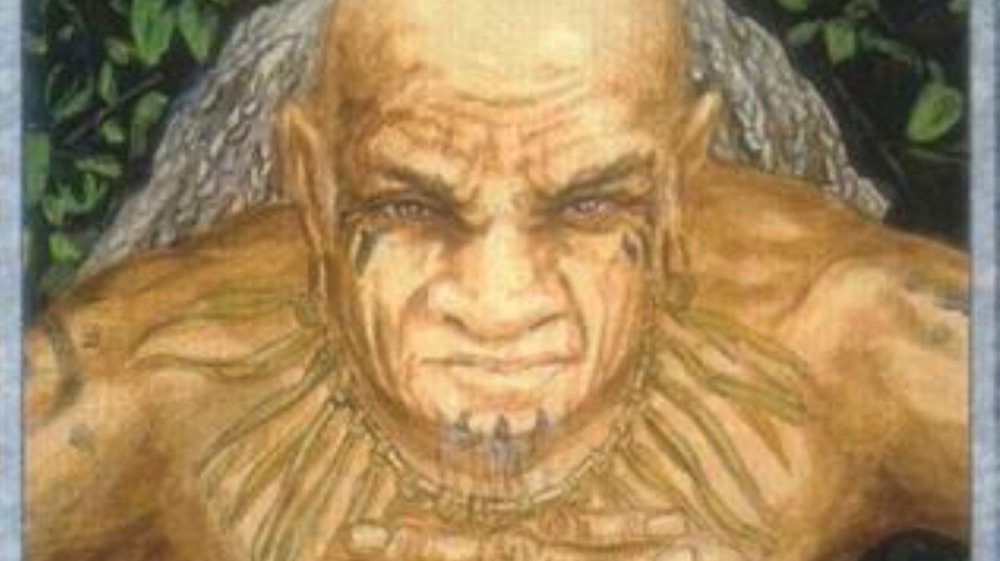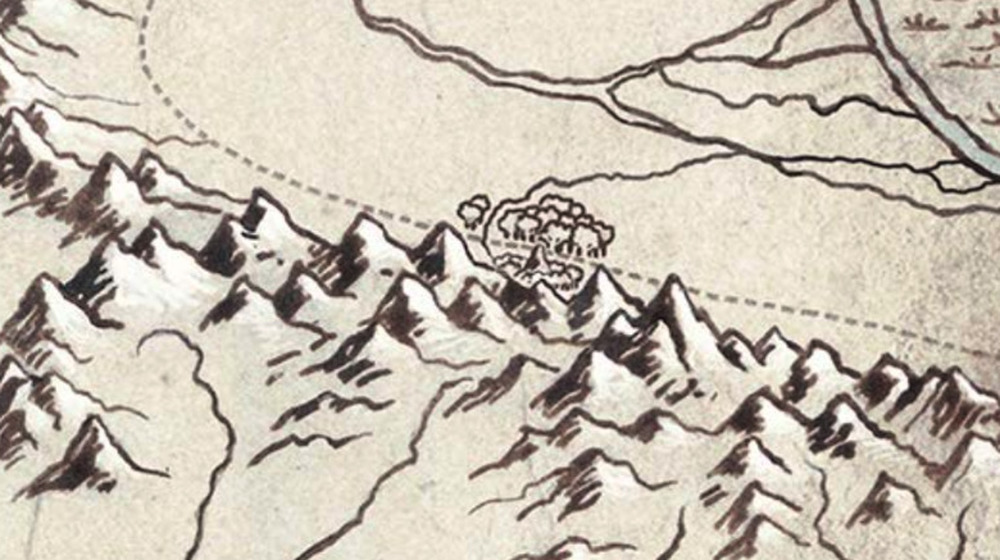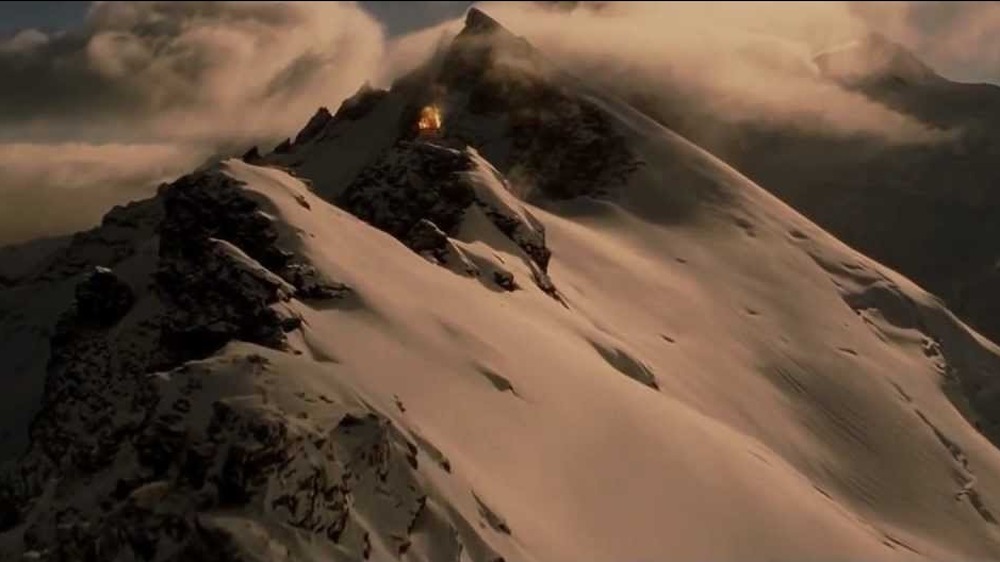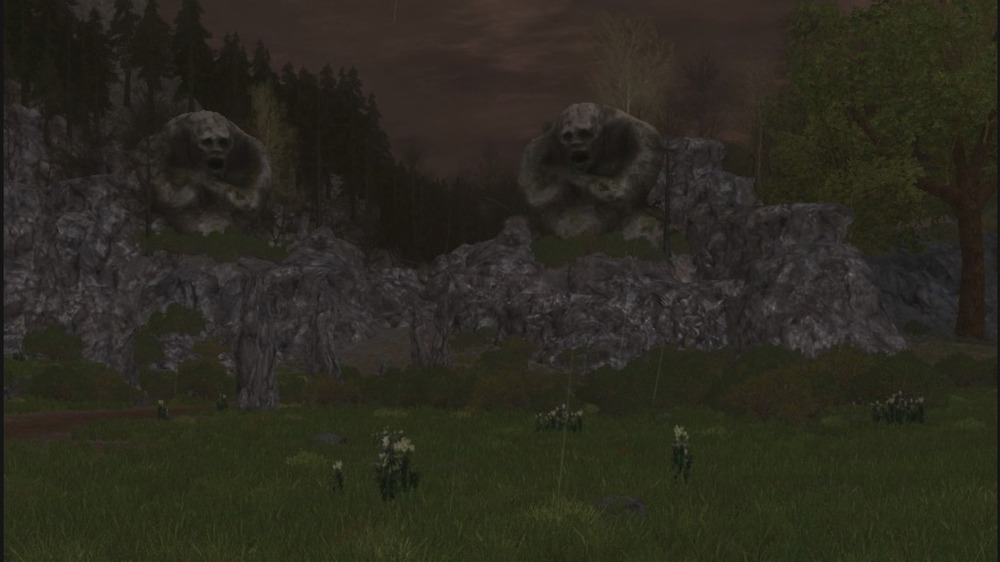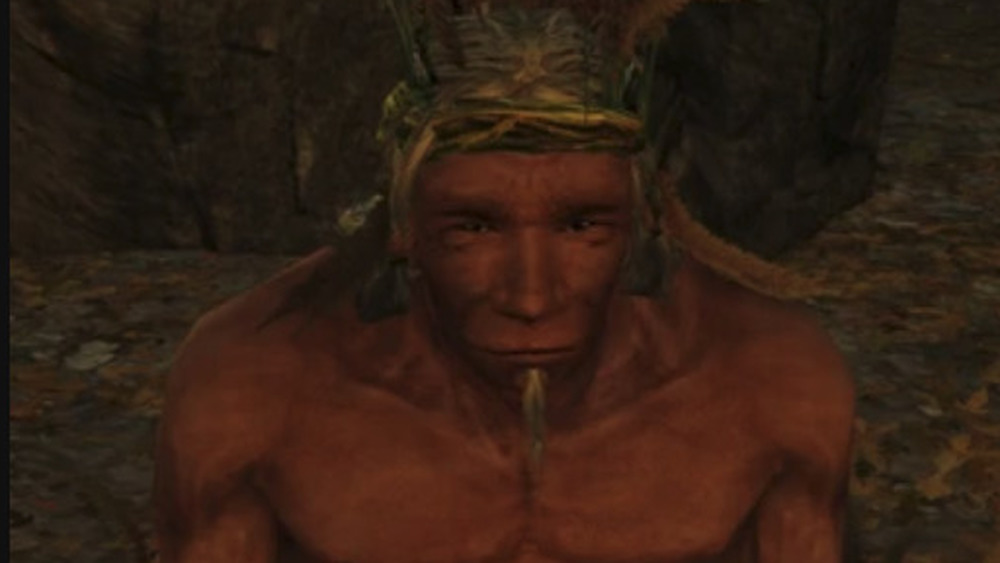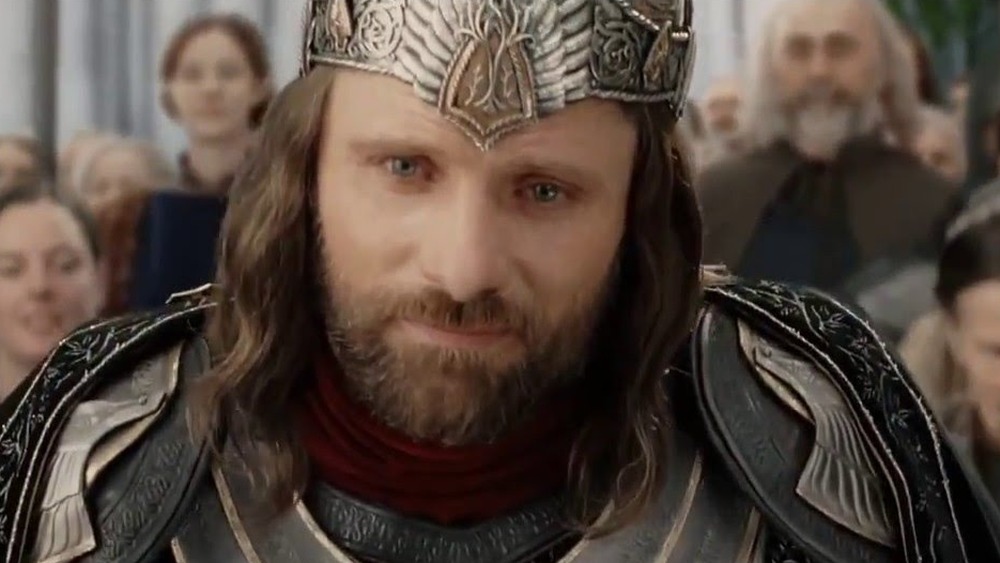Who Are Ghân-Buri-Ghân And The Drúedain? Tolkien's Mysterious Wood People Explained
The Hobbit trilogy suffers from an overabundance of characters and storylines that came from a tragic attempt to turn a few hundred pages of text into over nine hours of cinema. The Lord of the Rings trilogy suffers from an opposite conundrum; the attempt to squeeze three long books and a massive world into less than twelve hours of runtime meant that there were a ton of characters left out of the Lord of the Rings movies. A couple of these character removals, though tragic, made perfect sense. For instance, Tom Bombadil's part in the story was easily cut out without interfering with the larger narrative — a fact that is still brought up by fans of the enigmatic character on a regular basis. However, there's a group of people that was also conveniently cut out due to its minor part in the story this is practically never brought up: Ghân-buri-Ghân and the Drúedain.
If the names don't ring a bell, that's because these Wild Men only show up for one brief chapter early in The Return of the King, when they play a major role in the proceedings leading up to the great Battle of the Pelennor Fields. The Drúedain and their chieftain may appear only briefly in the story, but they are important pieces of the larger Middle-earth fabric nonetheless. As fans of Tolkien's fantasy are well aware, even the smallest characters get the red carpet treatment in his world — and this unusual offshoot of the race of Men is no exception to the rule. With that in mind, here is a truly brief breakdown of the somber chief Ghân-buri-Ghân and his hidden people, the Drúedain. We'll tackle who they are, how long they've been around, and just why their part in the War of the Ring was so easy for Sir Peter Jackson to cut out of the script.
A forgotten people ...who liked it that way
Tolkien's world is filled with a vast variety of different cultures. Even within each race, there are many different iterations, lifestyles, and representations. Nowhere is this more obvious than with the Drúedain. Also known as the Púkel-men, Woses, or the Wild Men of the Woods, the group is technically a race of Men. They are short and stumpy individuals who are often compared with Dwarves and even Hobbits — though Tolkien made it clear that they are their own distinct people group. They have unique features, such as sparse hair and wide faces, and are often described as having short lifespans, even for their own mortal race.
The Drúedain are around from very early on in Tolkien's writings. However, they are always peripheral characters, barely seen, or heard, or interacted with. In fact, the race is often depicted as a collective victim of the larger groupings of Orcs, Men, and other races that surround them. This is why they often show up either on the move or living in empty, forested lands where they can live in peaceful solitude, undisturbed by the larger, warlike people tramping around Middle-earth with conquest in mind.
The isolated group is described as often expressionless and able to stand stock-still for days at a time. They also speak in low, guttural voices. Nevertheless, in Tolkien's posthumously published book The Unfinished Tales, the author explains that "their laughter was a surprise," adding that it was "rich and rolling, and set all who hear it...laughing too for its pure merriment untainted by scorn or malice." This infectious laugh is more common earlier in their history when they interacted with others more often. By the time of The Lord of the Rings, though, they've more or less cut off all contact with the outside world.
A strange Middle-earth culture
The Drúedain are one of the most fascinating cultures that Tolkien ever invented. The primitive nation of individuals has a very tribal feel. They dwell in the heart of the woods and are known for their woodcraft. The Drúedain are also good when it comes to working with stone and are expert hunters and trackers and live a Spartan lifestyle. In another posthumously published volume, The Peoples of Middle-Earth, we discover that they "ate sparingly even in times of peace and plenty, and drank nothing but water." It also describes their dwellings as "tents or shelters" loosely built around trees, although they would occasionally use caves to hide in when the weather was really bad, as well.
Along with their austere lifestyle, the Drúedain are known for their own unique style of Middle-earth magic. They are described as having "strange powers," and their entire schtick is dependent on mysterious overtones and a sense of supernatural foresight. In The Return of the King, their chieftain prophesies to the Rohirrim, and Tolkien writes other stories in which they set up magical statues that can come to life and act for them when they're absent. Merry sees similar statues when he arrives at the muster of Rohan high up in the mountains, as well. Along with more fearsome magic, the Drúedain are renowned as healers, too.
While they can be stoic and even happy at times, when the Drúedain are angry or threatened, they became fearsome enemies. Their dark, black eyes glow red, and they relentlessly hunt down their enemies, killing them with poisoned arrows. This reputation as fearsome hunters creates a sense of doom around the forests where they live. It keeps Orcs and other creatures away and allows the secluded group to live in peace.
Tracing the history of the Pûkel-Men
Over the long course of Middle-earth history, the Drúedain are slowly driven from one location to another as they seek to stay clear of the larger events of the outside world. They always avoid or fight against the servants of the Dark Lords Morgoth and Sauron. While they're always on the right side of history, though, they also have their fair share of run-ins with many of the Free Peoples of Middle-earth as well — especially their fellow Men.
The Drúedain appear on the scene early on. In some cases, they find themselves in amicable circumstances, even living alongside other groups of Men. In other areas, though, Men hunt them down, turning them into something of an endangered species in the process. After the First Age, some of the Drúedain go to live on the isle of Númenor — a famous nation of Men that will be front and center in Amazon's upcoming Middle-earth show. Eventually, their clairvoyance gets the better of them, and the Wild Men return to the mainland, avoiding the catastrophic ending of the island nation in the process. Even so, once back on the continent, the Pûkel-men run right back into the gauntlet. They're harried and hunted by others, and continue to live a hidden life in various wooded areas, primarily around the region that eventually becomes known as Gondor.
As the Third Age slowly creeps by, the history of the Drúedain becomes quieter and quieter. They are hunted by both the servants of Sauron and the Rohirrim. Eventually, most of the survivors can be found either around the edges of the White Mountains of Gondor — the same range that is shown in that epic beacon-lighting sequence in The Return of the King — or in the sparsely settled southwestern portion of that nation.
Ghân-buri-Ghân and the War of the Ring
At this point, we've reached the part of the story where the Pûkel-men cross into the main Lord of the Rings narrative. However, unless you've read the books, their part even in that mighty conflict likely remains shrouded in mystery. Fortunately, that's what we're here to tell you about. At the time of the War of the Ring, one of the main surviving Drúedain settlements is located in a forest between Gondor and Rohan. This group is led by a wise man named Ghân-buri-Ghân. As the Rohirrim ride as fast as possible to rescue the besieged Minas Tirith, they find that the nearby road has been blocked by a large army. Barricades have been set up, and it appears that the Rohirrim will not only have to fight a huge battle before the main battle, but they'll also lose the element of surprise.
It's at this point, as they pass through the tiny, supposedly haunted Drúadan Forest, that Ghân-buri-Ghân appears out of nowhere offering help. The squat chieftain has a spur-of-the-moment council with Théoden and Éomer and offers to help the Rohirrim — whom he does not particularly love — defeat the invading Orcish armies — which he absolutely loathes. Rather than helping in the actual fighting, which is not his people's way, Ghân-buri-Ghân offers to lead the army through a little-known, long-abandoned path that circumvents their entrenched enemies on the main road. He does this with the help of his tribesmen and the army of Rohirrim manages to sneak around their enemies. As such, in The Return of the King movie, the Rohirrim are able to suddenly appear out of nowhere and flank the Witch-king's armies. It's also why it was so easy to simply write the arboreal side-adventure right out of the movie script.
The Drúedain and the Fourth Age
After providing an exquisite shortcut for the army of Rohan to take advantage of, Ghân-buri-Ghân and his people sink into the background for the rest of the story. However, they do make one more indirect appearance before all is said and done. After the war is over and the One Ring is destroyed, Aragorn rides part of the way home with the rest of the surviving members of the Fellowship of the Ring. During this journey, they pass by the wooded homeland of the Wild Men. The returned king is well aware of the help that these hidden people provided to his allies. He's also been told the price that they requested for their aid. Before their chieftain had parted ways with Théoden, he stated that the only form of payment for his people's help would be for the Rohirrim to kill Orcs. Tons of them. The one other request that he mentions is that "if you live after the Darkness, then leave Wild Men alone in the woods and do not hunt them like beasts any more."
With this in mind, as they pass the wood, Aragorn has trumpets blown and announces that "The Forest of Drúadan he gives to Ghân-buri-Ghân and to his folk, to be their own forever; and hereafter let no man enter it without their leave!" At this point, drums are heard beating loudly from deep inside the wood. Then they go silent, and the Drúedain don't enter the story ever again.
